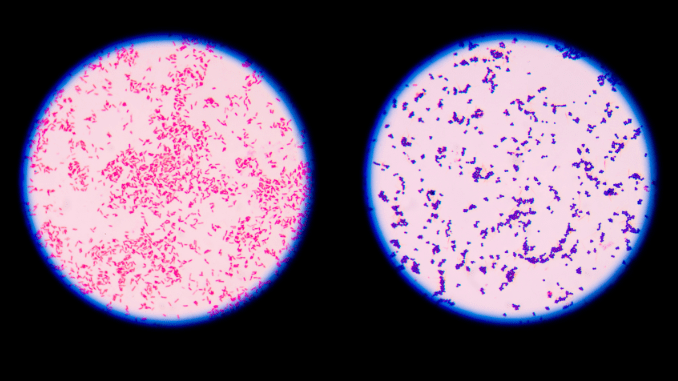
What is gram staining?
Gram staining is the most important procedure in microbiology. It is a laboratory technique that forms the basis of bacterial identification and taxonomic division. The following article is about gram staining and the Method or process used for the gram staining bacillus subtilis
Discovery
Gram staining was discovered by Danish physician and bacteriologist Hans Christian Gram in 1884.
Uses
This procedure separates bacteria into two groups Gram positive and Gram negative based on cell wall composition. Gram staining can also be used to diagnose fungal infections.
The staining procedure also helps to observe the shape, size, and clumping pattern of bacteria.
In this article, we will learn more about the Gram staining technique in bacteria.
Principle
Gram staining is a differential staining procedure that separates bacteria on certain properties of bacterial cell walls.
Bacteria can retain the crystal violet stain because of the presence of a thick layer of peptidoglycan in cell walls. These bacteria are classified as Gram-positive.
Bacteria that can’t retain the crystal violet stain are gram-negative bacteria. They have a thin layer of peptidoglycan surrounded by an outer lipid layer.
Procedure
Materials required
Crystal violet (Primary stain ), Gram’s iodine (mordant to fix crystal violet in the cell wall), Ethanol or Acetone (decolorizer), Safranin ( counter stain), Sterile water in a dropper bottle, Microscope glass slides, Blotting paper, Dropper, Compound microscope.
Steps
Staining
- A slide is taken and cleaned with ethyl alcohol. A drop of sterile water is placed on it. With the help of a sterilized inoculation loop bacterial culture is placed in a thin film on the slide.
- The bacterial smear is air-dried.
- The slide is now passed through flame to heat fix it. This kills the bacteria in the smear. Heat fixing adheres the smear firmly to the slide surface. It enables the sample to take up stains more readily.
Fixing the stain
- Crystal violet dye is added to the smear for 60 seconds.
- The slide is rinsed gently with sterile water. Gram iodine (mordant) is then applied for 60 seconds. Iodine increases the interaction between cell and dye for a strong stain.
Decolorizing the cells
- Rinse the slide with sterile water and apply 95% ethyl alcohol (decoloriser) for 20 seconds. The alcohol should not be left for too long. If left for too long it can cause decolorisation of all specimens and not yield desirable results.
- The slide is again rinsed with sterile water.
Applying counterstain
- A counter-stain safranin is applied for 60 seconds.
- Now the slide is rinsed gently with sterile water. Blot dry with bibulous ( blotting paper used to absorb dyes from slide surfaces) paper .
- Place a drop of oil on the slide; examine under 100 x objective.
The gram-positive cells appear purple or blue under the microscope.
The gram-negative cells appear red or pink under the microscope.
Gram staining Bacillus subtilis
- Bacillus subtilis is a gram-positive rod-shaped bacterium that forms heat-resistant dormant spores. These spores can survive long in harsh environments.
- It is nonpathogenic to humans. It is a probiotic (good bacteria) found naturally in the human gut.
- It has a thick cell wall, and cytoplasmic membrane but has no outer membrane. The cell wall has a thick peptidoglycan( sugar and amino acid molecule) layer called murein. This rigid layer helps the bacteria maintain the rod shape of the cell.
- Subtilis contains only one double-stranded DNA molecule within a circular chromosome.
- Bacillus subtilis can be found in soils, and roots of plants. It can even grow in the GI tract of animals.
- It serves as a model organism for studies of sporulation, and behavior of low Guanine and cytosine nucleotides in their DNA.
- It produces commercially important products like proteases and amylases.
- This bacteria plays a major role in the production of fermented food products, flavor enhancers, and sweeteners.
- Subtilis can produce bacteriocins – peptides that possess antimicrobial activity. Thus it is a potential treatment against bacterial infection.
- It serves as a model organism for the development of sporicides – a chemical agent that kills spores.
References
Microbiology: Principles and Explorations. by Black, Jacquelyn G.
| About the Author
Ahana Mitra, a zoology teacher with 22 years of experience, excels in teaching higher classes. Her strength lies in understanding students’ specific needs and simplifying complex biological concepts into clear, precise lessons. |
